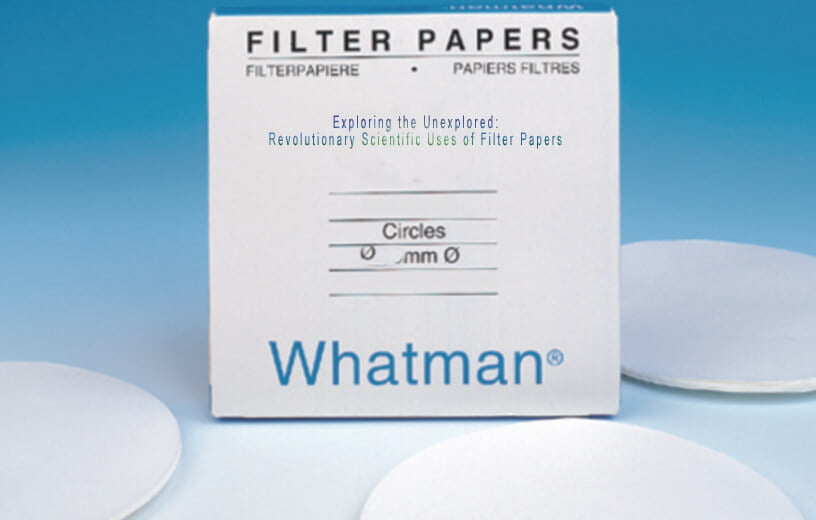- Water Testing Meters
- Anemometer
- Length & Distance Meter
- Multimeter & Clamp Meter
- Light and Sound Meter
- Slide Calipers & Screw Gauge
- Thermometer & Hygrometer
- Milk Testing Meters
- Paper, Grain & Wood Testers
- Stopwatch & Timers
- Soil Testing Meters
- Refractometers & Analyzer
- Magnetic Compass
- Tachometer & Megger
- Thickness & Dia-Meters
- Other Meter And Accessories
Exploring the Unexplored: Revolutionary Scientific Uses of Filter Papers

Filter papers may seem like a humble tool in the world of scientific research, but their potential uses extend far beyond simple filtration. The advent of filter paper technology has paved the way for revolutionary scientific advancements, with researchers finding innovative ways to utilize these seemingly ordinary papers. From DNA extraction and environmental monitoring to drug discovery and water purification, filter papers have become indispensable in various scientific fields. In this blog, we will explore the unexplored and delve into the extraordinary scientific uses of filter papers, shedding light on the remarkable role they play in pushing the boundaries of scientific research.

The historical significance of filter papers in scientific research
In order to fully appreciate the revolutionary scientific uses of filter papers, it is important to acknowledge their historical significance in scientific research. The concept of using filter papers as a tool for scientific experimentation dates back centuries, with early pioneer experiments being conducted as far back as the 19th century. These initial experiments laid the foundation for future advancements in filter paper technology, ultimately leading to the diverse range of applications we see today.
Filter papers have been instrumental in myriad scientific breakthroughs throughout history. From the discovery of new compounds to the understanding of environmental pollutants, these humble papers have played a crucial role in advancing our understanding of the world around us. By charting the historical journey of filter papers, we gain a deeper appreciation for the ongoing research and innovation that continues to push the boundaries of scientific discovery.
Stay tuned as we explore the fascinating historical context and delve deeper into the extraordinary scientific uses of filter papers in the next section of this blog.
Advancements in filter paper technology and innovative scientific applications
In the previous section, we discussed the historical significance of filter papers in scientific research. Now, let’s delve deeper into the advancements in filter paper technology and the innovative scientific applications that have emerged as a result.
Over the years, filter paper technology has evolved significantly. From simple filtration to more sophisticated uses, researchers have developed new types of filter papers with enhanced properties for specific scientific needs. For instance, advancements in nanotechnology have paved the way for the creation of nanoporous filter papers, which allow for ultrafiltration of particles on a molecular scale. This breakthrough has revolutionized fields such as drug delivery systems and biotechnology, as it enables the isolation and separation of tiny particles and biological molecules with unparalleled precision.
In addition to their filtration capabilities, modern filter papers have also been utilized in innovative scientific applications. One such example is the use of filter papers in forensic investigation. By performing chromatographic analysis on filter paper strips, forensic scientists can identify and analyze trace amounts of substances found at crime scenes, aiding in the detection and prosecution of criminals.
Furthermore, with increasing concern for environmental sustainability, filter papers have also found unique applications in environmental monitoring and conservation efforts. They can be used to assess water and air quality, helping researchers and regulatory bodies to identify and mitigate environmental pollutants effectively.
The advancements in filter paper technology have not only expanded the realm of scientific possibilities but have also made research more accessible. Filter papers are relatively inexpensive, widely available, and easy to use, making them a go-to tool for scientists across various fields.
Next, we will explore specific scientific disciplines where filter papers have made significant contributions. From medical research to food analysis, we will highlight the outstanding achievements and ongoing research that utilize this versatile material. Stay tuned for an exciting dive into the world of filter papers in scientific innovation.
Uses of Filter papers in microbiology: A vital tool for bacteria and virus analysis
In microbiology, filter papers have become a vital tool for the analysis of bacteria and viruses. Due to their pore size and filtration capabilities, filter papers can effectively capture microorganisms from a variety of samples, such as water, air, and biological fluids. This has led to significant advancements in microbiological research and diagnostics.
One of the key applications of filter papers in microbiology is microbial enumeration. By filtering a liquid sample through a filter paper, scientists can collect and count the microorganisms present. This information is crucial for understanding microbial populations, studying their behavior, and assessing the efficacy of antimicrobial agents.
Moreover, filter papers are also widely used in the detection and characterization of viruses. By filtering a virus-containing sample through a filter paper, researchers can concentrate and extract viral particles for further analysis. This technique has been instrumental in studying the infectious mechanisms of various viruses, developing vaccines, and designing effective antiviral treatments.
Additionally, filter papers play a crucial role in the field of environmental microbiology. By collecting samples from different environments, such as soil or water, scientists can analyze the microbial communities present, helping to understand their ecological roles and interactions. This information is essential for environmental monitoring, assessing the impact of pollution on microbial ecosystems, and identifying potential bioindicators.
In the next section, we will explore how filter papers have revolutionized medical research, particularly in the areas of drug discovery and development, tissue engineering, and diagnostic testing. Stay tuned to discover the incredible contributions of filter papers in the field of medicine.
The role and uses of filter papers in environmental science: Monitoring water quality and air pollution
Filter papers have proven to be incredibly valuable in the realm of environmental science. They play a vital role in monitoring water quality and assessing the levels of air pollution.
In the field of water quality monitoring, filter papers are frequently utilized to collect and analyze samples from rivers, lakes, and other bodies of water. By filtering the water through a paper, scientists can capture suspended particles, sediment, and other contaminants. This allows them to measure important parameters such as turbidity, total suspended solids, and levels of heavy metals. These measurements are critical for assessing the health of aquatic ecosystems, identifying pollution sources, and implementing effective conservation strategies.
Similarly, filter papers are essential tools in air pollution monitoring. By placing filter papers in designated locations, researchers can collect and analyze particulate matter suspended in the air. This helps measure the levels of pollutants such as dust, pollen, bacteria, and emission particles. Understanding air quality and identifying pollution sources is crucial for public health and implementing appropriate measures to reduce pollution and its negative impacts.
The use of filter papers in environmental science allows researchers to gather accurate data for decision-making and policy implementation. By utilizing this versatile tool, scientists can contribute to the preservation and restoration of our ecosystems. In the following section, we will delve into the significant contributions of filter papers in the field of medicine, including drug discovery and development, tissue engineering, and diagnostic testing. Stay tuned to uncover the innovative uses of filter papers in the medical field.
Filter papers in the pharmaceutical industry: Purification and drug delivery systems
In addition to their applications in environmental science, filter papers have made significant contributions to the field of medicine, particularly in the pharmaceutical industry. Their unique properties make them valuable tools in drug discovery, purification, and delivery systems.
Filter papers are commonly used in the purification process of pharmaceutical compounds. They serve as an effective medium for separating impurities from the desired substance, ensuring the production of high-quality drugs. By utilizing filter papers, pharmaceutical companies can enhance the efficiency and effectiveness of their purification processes, ultimately improving the quality and safety of the medications they produce.
Another area where filter papers are instrumental is in drug delivery systems. These papers can be used as a matrix to deliver medications through controlled release mechanisms, enabling precise dosing and targeted therapy. Filter papers have the ability to hold and release pharmaceutical compounds in a controlled manner, ensuring optimal drug delivery to the desired target site.
Moreover, filter papers have gained recognition in tissue engineering. They can serve as scaffolds for the growth and development of cells and tissues, providing a supportive structure for tissue regeneration. Filter papers’ porosity and biocompatibility make them ideal for cultivating cells and promoting tissue formation, offering promising possibilities in the field of regenerative medicine.
The versatile nature of filter papers allows them to contribute to the advancements in pharmaceutical research and development. Their use in purification, drug delivery systems, and tissue engineering showcases the remarkable potential for filter papers in revolutionizing medical science. As we explore further, we will uncover the groundbreaking role filter papers play in diagnostic testing. Stay tuned to discover their exciting applications in the medical field.
Exploring new frontiers: Emerging applications of filter papers in nanotechnology and biotechnology
Filter papers have not only made significant contributions to the pharmaceutical industry but are also being explored in other cutting-edge fields such as nanotechnology and biotechnology. Their unique properties and versatility make them valuable tools for various applications in these fields.
In nanotechnology, filter papers are being used as a template for synthesizing nanoparticles with precise size and shape. These papers provide a structured surface for the controlled growth of nanoparticles, allowing researchers to create nanomaterials with tailored properties for a range of applications, from electronics to healthcare.
In biotechnology, filter papers are being utilized as a platform for DNA extraction and purification. Their ability to efficiently capture and retain nucleic acids makes them an ideal medium for isolating DNA from biological samples, such as blood or saliva. Filter papers offer a cost-effective and user-friendly alternative to traditional DNA extraction methods, enabling advancements in genomics research and diagnostic testing.
The emerging applications of filter papers in nanotechnology and biotechnology hold great promise for advancements in these fields. As we delve deeper into the unexplored possibilities, stay tuned to discover how filter papers are being harnessed to revolutionize these cutting-edge disciplines.
Challenges and opportunities in the future of filter paper research
Filter papers have undoubtedly proven their worth in various scientific fields, but like any technology, they face their own set of challenges and opportunities. One of the major challenges in filter paper research is the need for improved filtration efficiency. While filter papers have shown impressive capabilities, there is always room for enhancement to achieve higher levels of filtration. Researchers are constantly exploring ways to optimize the pore size and distribution, as well as the structural integrity of filter papers, to maximize their filtration efficiency.
Another challenge is the development of specific filter papers for specialized applications. As new scientific discoveries emerge, there is a growing demand for filter papers tailored to meet the unique requirements of different industries. This involves designing papers with specific surface chemistries, flow rates, and particle retention capacities. Addressing these challenges will open up new opportunities for filter paper research and enable their use in an even wider range of applications.
Looking ahead, the future of filter paper research holds great potential. Advancements in nanotechnology and biotechnology are expected to further expand the horizons of filter paper applications. As scientists continue to push the boundaries, we can expect to see filter papers being utilized in groundbreaking ways, contributing to the development of new materials, diagnostics, and technologies.
In our next section, we will dive deeper into the specific challenges and opportunities that lie ahead in the realm of filter paper research. Stay tuned to learn how researchers are addressing these challenges and uncovering new possibilities for filter paper applications.
Conclusion: Embracing the extraordinary potential of filter papers in scientific breakthroughs
Filter papers have undoubtedly proven their worth in various scientific fields, but like any technology, they face their own set of challenges and opportunities. One of the major challenges in filter paper research is the need for improved filtration efficiency. While filter papers have shown impressive capabilities, there is always room for enhancement to achieve higher levels of filtration. Researchers are constantly exploring ways to optimize the pore size and distribution, as well as the structural integrity of filter papers, to maximize their filtration efficiency.
Another challenge is the development of specific filter papers for specialized applications. As new scientific discoveries emerge, there is a growing demand for filter papers tailored to meet the unique requirements of different industries. This involves designing papers with specific surface chemistries, flow rates, and particle retention capacities. Addressing these challenges will open up new opportunities for filter paper research and enable their use in an even wider range of applications.
Looking ahead, the future of filter paper research holds great potential. Advancements in nanotechnology and biotechnology are expected to further expand the horizons of filter paper applications. As scientists continue to push the boundaries, we can expect to see filter papers being utilized in groundbreaking ways, contributing to the development of new materials, diagnostics, and technologies.
In our next section, we will dive deeper into the specific challenges and opportunities that lie ahead in the realm of filter paper research. Stay tuned to learn how researchers are addressing these challenges and uncovering new possibilities for filter paper applications. Embracing the extraordinary potential of filter papers in scientific breakthroughs is crucial in advancing various scientific fields and revolutionizing the way we approach filtration.






